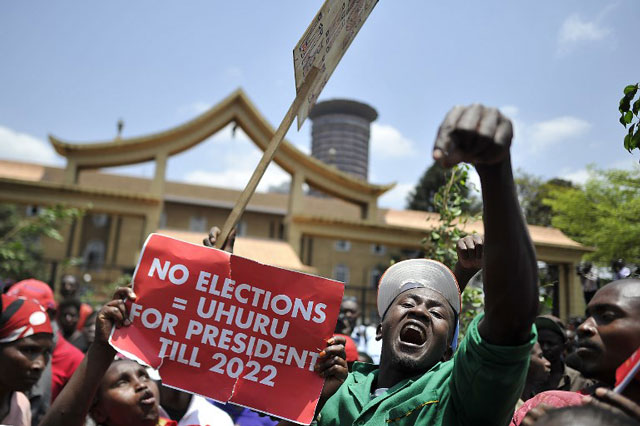
Nairobi, Kenya | AFP | Kenyan opposition leader Raila Odinga’s withdrawal Tuesday from a re-run of the presidential election is the latest in a series of dramatic developments over the disputed vote:
– Tense vote –
Kenyan voters turn out in large numbers on August 8 after a tight race between President Uhuru Kenyatta and Odinga, his longtime rival.
There are fears the bad-tempered campaigning will lead to violence. More than 1,100 people were killed in politically motivated tribal violence after the 2007 election.
Early results give Kenyatta a comfortable lead but are immediately rejected by Odinga, who claims hackers broke into the electoral commission database and manipulated the results.
The official results are published on August 11 and give Kenyatta 54.27 percent of votes to Odinga’s 44.74 percent.
Angry protests erupt immediately in Odinga strongholds. The violence continues for days. The Kenya National Commission on Human Rights says 37 people are killed, most of them by the police.

– Historic annulment –
Odinga takes his complaints to the Supreme Court. In a shock announcement, its judges on September 1 declare the results of the poll “invalid, null and void” and orders a re-run within 60 days.
The annulment is a first for Africa.
The date for the new election is later announced as October 17.
A confidential memo in which the Independent Electoral and Boundaries Commission (IEBC) admits to irregularities and failings in the conduct of the vote is made public on September 7.
– Uncertainty –
As doubts grow over Kenya’s ability to hold a rerun of its presidential election, the French biometrics firm OT-Morpho that provides the electronic voting system says on September 18 it will not be ready in time.
The Supreme Court issues days later a detailed judgement lambasting the IEBC for failing to properly conduct the election.
The commission announces that it has to push the re-run back to October 26 in order to prepare.
Kenya’s chief prosecutor on September 23 orders an investigation into the commission over the conduct of the vote.

– New protests –
Late September the ruling Jubilee Party introduces a bill seeking to resolve “ambiguity” in the electoral law.
The opposition slams the move as an effort to render legal some of the “irregularities and illegalities” cited in the Supreme Court’s cancelling of the vote.
Protests erupt in early October as Odinga calls on his supporters to pressure the government to overhaul the election commission, threatening he will not take part in a re-run otherwise.
On October 10 he withdraws from the re-run, saying the election panel has failed to make needed reforms.
But he also indicates this does not mean his battle is over, citing legal arguments his party believes will compel election officials to begin the whole process from scratch.
 The Independent Uganda: You get the Truth we Pay the Price
The Independent Uganda: You get the Truth we Pay the Price



Now all those of you – who naively ‘jubilated’ on the justices’ ruling – thinking it was a ‘solution’ to election malpractices and that it would pave a brand new ‘progress’ road for Kenya (and by example, Africa), can pose and ruminate on these events.
Poor Africa is spending too much time, material and human resources on useless, even dangerous politicking fiascos. The more intelligent among us should be focusing more on activities that more directly benefit our peoples as one.